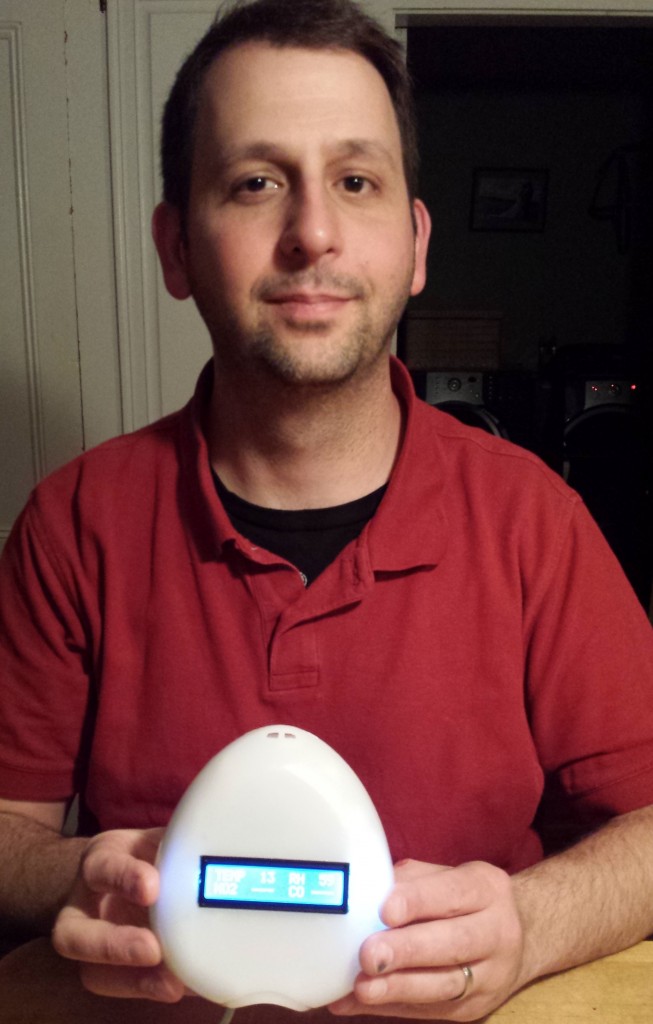Podcast: Play in new window | Download
Subscribe: Apple Podcasts | RSS
Welcome Vic Aprea (@vicatcu) from Wicked Device!
- Vic offered listeners of The Amp Hour 20% off at the Wicked Device store. Get your Air Quality Egg today! Use coupon code, “theamphour”
- Vic’s first computer was a C64 and then he graduated onto the 486dx. Dave shared a story about fake cache memory from the 90s.
- While attending Cornell University, Vic was one of the first students of Bruce Land’s microcontroller class. Bruce is also very active on the Hackaday projects site.
- The microcontroller class site and the YouTube channel continue to be a great resource for beginners, students and hobbyists. You can watch the entire course online as well. Here’s the first video:
[tube]https://www.youtube.com/watch?v=dT0xxaG1DhM[/tube] - After undergrad, Vic stayed on at Cornell and taught a course in computer architecture.
- Once the early 2000s slump started to subside, Vic joined Lockheed Martin in Owego NY. He was working on various systems that fed into the display for military helicopters. The site was previously IBM’s federal systems division.
- During this time, Vic started working with a local group that did enrichment activities like launching weather balloons with instrumentation on board. This lead to Vic getting his ham license (KC2QLW).
- The radio on board was a small FSK radio, similar to the one used on the Wicked Device Node. They also use the Amateur Packet Reporting System (APRS) using a Yaesu FT-60R.
- The balloon project required multiple ways to abort the mission. One was “cutting” the string using devices that contained black gun powder.
- Apparently there are 1000s of balloons per day. NOAA alone launches 70K per year (~180/day). These help inform weather forecasters about high altitude winds. Many balloons are never recovered.
- Chris was reminded of hint.fm, which shows awesome visualization of wind; however, this is likely done from networked ground stations, not balloons.
- Vic said that the balloons can experience odd weather patterns and strong shear wind forces. Chris wondered how this would have affected jetman. A new video came out from Dubai recently and it’s awesome:
[tube]https://www.youtube.com/watch?v=Czy0pXRRZcs[/tube] - After working with balloons for a while, Vic met his current business partner Dirk Swart. They started Wicked Device, which is a product design and manufacturing company.
- They were tapped to design and distribute the Air Quality Egg (AQE), which had a successful Kickstarter back in 2013.
- The egg uses a reporting service called Xively, formerly Patchube (“patch-bay”).
- The sensors work with chemical reactions; this in turn changes the resistance of the sensor. They currently have CO2, NO2 and a few others.
- The choice of sensors was informed by the list from NAAQS
- On board the AQE v1 there was a RFM12B FSK radio and an ENC28J60.
- Since they were between low and high quantity, they decided to manufacture in house. They bought a used Mancorp Pick and Place machine, which seemed to go surprisingly well. Vic had to redesign the board to move away from through hole components.
- Doing sensor linearization and conversion proved difficult. Vic had to do fixed point math on the smaller processor to get the sensors behaving as expected. They also used sensors never meant for absolute measurements.
- For v2 of the AQE, they began develping the WiLDFiRE, which is now available. Since it has a wifi module, the remote code loading can be tricky. Vic wrote about the bootloader here.
- Each sensor has its own micro and individual firmware, which caused some of the headaches. They communicate using RS232 (serial) protocol without the level translators. The EggBus is over I2C. Vic had emailed after last week’s show where we talked about delivering firmware payloads to a variety of devices.
- The AQE v2 is available to purchase now. You can also see the planned upgrades for the future.
- If you’re interested in contributing to the Air Quality Egg project, email victor dot aprea at wickeddevice dot com.
Many thanks to Vic for stopping by and talking about the projects he has worked on. Remember you can get a discount using the coupon code “theamphour” over at wickeddevice.com


Fake cache was a solo job by one Taiwan fly by night manufacturer PCChips. They started with 486 boards, continued on Socket 5/7 ones with an added bonus of fake chipsets (invented names like VXPro+), and fizzled out on slot 1/fcpga pushing worst SiS chipsets possible (~20-30% slower than Intel counterparts with same cpu and ram used, not to mention crashing all the time). Prices were so lucrative even big respected pc parts suppliers/importers couldnt resist. I worked for second biggest Polish pc parts supplier at the time in RMA center, someone had a brilliant idea importing a bunch of their slot1/fcpga boards at 1/3-1/4 Intel/via price (!!!). We were having returns on 100% working ones too, because people couldnt believe how bad they were, but the profit was excellent :/
Scary to hear how enthusiastic Vic is about brick^^^^updating firmware from the mothership without user interaction/decision. iot is teh evul.
It’d be cool if in the future a single Air Quality Egg device can measure all pollutants (PM, lead, VOCs, NO2, O3,etc)
About adding WiFi, the esp8266 seems quite popular, but appraently programmed in NodeMCU’s LUA?!
http://benlo.com/esp8266/esp8266Projects.html#hotspotfinder
Regarding the lessons learned in crowdfunding, I ran across the tech etsy-like marketplace, but aside from wimoto, haven’t ever heard you guys or anyone else ever mention it alongside kickstarter, anyone know if it’s any good?
https://grandst.com/
Finally, that youtube video of jetman, reminded me of that cool eagle video from Dubai:
https://www.youtube.com/watch?v=6g95E4VSfj0
By the way. There’s more than just one airport in Nova Scotia but only Stanfield is a big International one so they’re probably the one who noticed the balloon. It could have also been CFB Shearwater.
http://en.wikipedia.org/wiki/List_of_airports_in_Nova_Scotia